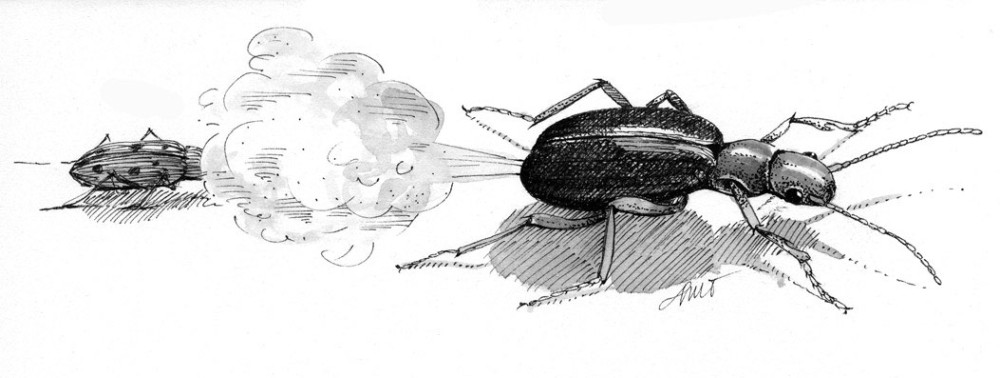
Some ground beetles are big and beautiful: shiny black or iridescent green or bluish. And because many of them are unable or reluctant to fly, they are easily caught; you can get a good long look at them as they wiggle to escape from your hand. They are members of the family Carabidae, and the common name, ground beetle, describes them well. That is where you will find them – especially the forest species – hiding under rocks and logs during the day, waiting for a night of feasting, mostly on live prey.
Good predators that they are, they disappear instantly when their log or rock is picked up, for most of them have strong legs. That’s about as much generalizing as you can do with this family of around 40,000 described species – perhaps the largest of all insect families – with 1,700 species in North America. A few, such as the snail-eating carabids, have very restricted diets and are shaped accordingly. An elongated head and hooked mandibles allow these beetles to reach deep into a snail shell and grasp the soft and luckless inhabitant. Ross Bell, an entomologist at the University of Vermont, told me that some snail eaters follow rodent burrows in pursuit of their prey and mimic the sound of a rattlesnake to intimidate any mice in residence.
Many ground beetles emit toxic secretions to fend off predators, an art perfected almost beyond belief by the group called bombardier beetles. Some people believe that the bombardiers’ elaborate mechanism for shooting blasts of boiling toxic chemicals out the back end cannot have come about through evolution. You have to admit, they have an argument, but one that has been countered, needless to say. Bell said that it is not difficult to find these mythical beetles right here in New England, and that anybody who looks in the right place can experience the popping sound of their explosions and see the tiny puffs of smoke.
Over millions of years, this successful family has conservatively held on to a simple body plan. A few sand-dwelling species are tiny and round with small legs, but most look like ordinary beetles. A few species consume seeds, and a few eat only one particular kind of insect, but most are not at all fussy about what they eat. Instead, they are picky, often extremely picky, about their habitat and often prefer to live within a very narrow temperature, humidity, light intensity, and/or pH limits – plus they may be sensitive to other factors that we aren’t even aware of. Some protect their eggs with a coating of clay, and if kept in peat they refuse to lay eggs.
Ground beetles have a simple social life, which makes them easier to study than ants or bees. As an added bonus, they don’t sting. At night you can catch large numbers of ground beetles in pitfall traps. In the simplest case, this is just a coffee can buried up to its rim in the ground.
Diverse, abundant, food generalists, habitat specialists, easy to feed, and easily caught: it all adds up to a ready-made ecological monitoring system and, indeed, that is what they are being used for nowadays. Trees, being very long-lived, are almost useless as ecological indicators. You have to do something terrible to a tree species before it disappears, but the composition and abundance of the insect community fluctuates at least annually, and conclusions can be drawn from careful monitoring of insect populations.
In Europe, ground beetles have been studied intensively, but in this country, efforts to correlate beetle populations with environmental change are at an early stage. Both the number of ground beetle species and the number of a particular species can indicate environmental changes. Within a small area, changes in the plant community will result in a very different assortment of ground beetles at the bottom of your pitfall trap.
Most forest species are almost never found in fields and, as a group, they tend to be nocturnal and flightless, preferring moist cool conditions.
Are they pests? Are they beneficial? Tree-climbing ground beetles in the genus Calosoma may be important predators on lepidopteran caterpillars, especially the saddled prominent. Other ground beetles eat earthworms. Several large Carabus species were brought here from Europe to control gypsy moths, and some of them have spread across the country, with little effect on gypsy moths, but a big effect on anyone who sees them: they are among the biggest, most iridescent, and most beautiful of all ground beetles.
If you set up a pitfall can, you can get a close look at these beetles and then release them where you found them. If you don’t have a field guide that includes beetles, try bugguide.net.


Discussion *